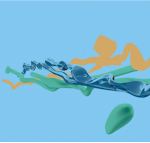“The story of Skábma is based on the Sámi mythology of The Celestial Hunt. The Celestial Bull Reindeer, Sarvvis, has been hunted through the ages by the Sons of Kalla from the constellation of Orion. If the hunters succeed in killing Sarvvis, the world will die. In the game, a young Sámi child, Áilu, gets mixed up with this endless hunt and accidentally initiates the end of the world.“
Students have been working hard over the summer with various projects and internships. One project in focus is project Skábma – Polar Night, originally titled “Kaamos.” A project which began during a game minor module in 2015, has now been developed into a fully-fledged project. The initial project was too big for the students to finish and they were unable to reach their goals. However, everything has a silver lining. Red Stage Entertainment then picked up the project several years later and are now working with some of the original creators.
Skábma is a 3D low-poly game developed in Unity. The team of 12 currently consists of animators, concept artists, a programmer, a director, level designer a producer and a writer. As well as people working on the music and SFX side of things. Producer/writer Marjaana Auranen is of Sámi descent to help make the game feel as authentic as possible.
Now that the project is taken more seriously, many changes were made to the original concept. Research is being done to make the game as accurate as possible. Such as researching the Sámi people and the way they live. Accurate environments have been created also, largely based on Lapland.
They have been working on the game since early June and work separately from TAMK and they were eventually funded to get the project going. Their main goal is to finish a demo to then promote to potential investors. The deadline to finish the demo was at the end of September, with the potential of producing the game further.
Fourth year interactive media students, Waltteri Lahti and Jerina Kivistö, spoke on behalf of the group to give me an insight to what they get up to during their time there. They are two of the creators of the original demo from 2015 and are now doing their practical training at the company.
Kivistö is a 2D artist who comes up with the concept ideas for the game. Her job is to start the process of a character design as well as some environmental aspects for the game using Photoshop. When creating a character or creature, she thinks in detail as to how it will work visually and realistically. She then takes the idea to the producer or director who then decides whether it needs changes or if it works. Most times she will go back and develop her concept idea before approval, a 3D modeller will then develop the idea further from her designs.
Skábma is a 3D low-poly game developed in Unity. The team of 12 currently consists of animators, concept artists, a programmer, a director, level designer a producer and a writer. As well as people working on the music and SFX side of things. Producer/writer Marjaana Auranen is of Sámi descent to help make the game feel as authentic as possible.
Now that the project is taken more seriously, many changes were made to the original concept. Research is being done to make the game as accurate as possible. Such as researching the Sámi people and the way they live. Accurate environments have been created also, largely based on Lapland.
They have been working on the game since early June and work separately from TAMK and they were eventually funded to get the project going. Their main goal is to finish a demo to then promote to potential investors. The deadline to finish the demo was at the end of September, with the potential of producing the game further.
 |
| Concept art for the game |
Fourth year interactive media students, Waltteri Lahti and Jerina Kivistö, spoke on behalf of the group to give me an insight to what they get up to during their time there. They are two of the creators of the original demo from 2015 and are now doing their practical training at the company.
Kivistö is a 2D artist who comes up with the concept ideas for the game. Her job is to start the process of a character design as well as some environmental aspects for the game using Photoshop. When creating a character or creature, she thinks in detail as to how it will work visually and realistically. She then takes the idea to the producer or director who then decides whether it needs changes or if it works. Most times she will go back and develop her concept idea before approval, a 3D modeller will then develop the idea further from her designs.
“How do I take those designs, and make them not stereotypical.” - Kivistö
Lahti is the games 3D artist who works on creating the 3D models working in Blender, but also works with the animations of the game including rigging the characters. His main aspirations for the project were to develop his animation skills, as this is what he enjoys most. However he has had to focus more on 3D modelling due to the commitments in the project.
"It's been fun and challenging but most of all really rewarding experience to work on this game." - Lahti
This project is a prime example of what students can achieve during their studies here in TAMK. Old projects from modules which do not reach their goals are never a waste of time. They can be built and worked on in the future leading to future job opportunities for the students. I am looking forward to trying out the demo when it is finally released.
You can look up Red Stage Entertainment at the following address for further updates and other projects!
http://www.redstage.fi/
http://www.redstage.fi/

 Suomeksi
Suomeksi









